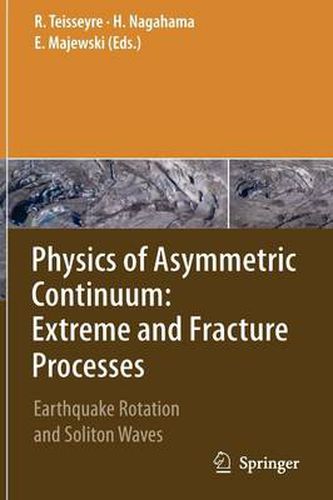Readings Newsletter
Become a Readings Member to make your shopping experience even easier.
Sign in or sign up for free!
You’re not far away from qualifying for FREE standard shipping within Australia
You’ve qualified for FREE standard shipping within Australia
The cart is loading…






This title is printed to order. This book may have been self-published. If so, we cannot guarantee the quality of the content. In the main most books will have gone through the editing process however some may not. We therefore suggest that you be aware of this before ordering this book. If in doubt check either the author or publisher’s details as we are unable to accept any returns unless they are faulty. Please contact us if you have any questions.
Our new monograph has been inspired by the former one, Earthquake Source Asymmetry, Structural Media, and Rotation Effects (R. Teisseyre, M. Takeo, and E. Majewski, eds, Springer 2006). Some problems, c- cerned primarily but not exclusively with the basic theoretical nature, have appeared to us as worthy of further analysis. Thus, in the present mo- graph we intend to develop new theoretical approaches to the theory of continua that go far beyond the traditional seismological applications. We also try to present the links between the experimental data, the observed rotational seismic waves, and their theoretical evaluation and description. In addition, we consider the basic point motions and deformations, and we intend to find the invariant forms to describe such point motions. We believe that there must exist the basic equations for all point motions and deformations, and we derive such relations within a frame of a continuum theory. Thus, in the considered standard asymmetric theory, we include relations not only for the displacement velocities but also for a spin motion and basic point deformations as well. We include here the axial point - formation and twist point deformation represented by the string-string and string-membrane motions. A twist vector is defined here as a vector p- pendicular to the string-string plane and representing its magnitude. It - comes an important counterpart to spin and a key to the presented theory. We show in the forthcoming chapters that the twist motion describes the oscillations of shear axes.
$9.00 standard shipping within Australia
FREE standard shipping within Australia for orders over $100.00
Express & International shipping calculated at checkout
Stock availability can be subject to change without notice. We recommend calling the shop or contacting our online team to check availability of low stock items. Please see our Shopping Online page for more details.
This title is printed to order. This book may have been self-published. If so, we cannot guarantee the quality of the content. In the main most books will have gone through the editing process however some may not. We therefore suggest that you be aware of this before ordering this book. If in doubt check either the author or publisher’s details as we are unable to accept any returns unless they are faulty. Please contact us if you have any questions.
Our new monograph has been inspired by the former one, Earthquake Source Asymmetry, Structural Media, and Rotation Effects (R. Teisseyre, M. Takeo, and E. Majewski, eds, Springer 2006). Some problems, c- cerned primarily but not exclusively with the basic theoretical nature, have appeared to us as worthy of further analysis. Thus, in the present mo- graph we intend to develop new theoretical approaches to the theory of continua that go far beyond the traditional seismological applications. We also try to present the links between the experimental data, the observed rotational seismic waves, and their theoretical evaluation and description. In addition, we consider the basic point motions and deformations, and we intend to find the invariant forms to describe such point motions. We believe that there must exist the basic equations for all point motions and deformations, and we derive such relations within a frame of a continuum theory. Thus, in the considered standard asymmetric theory, we include relations not only for the displacement velocities but also for a spin motion and basic point deformations as well. We include here the axial point - formation and twist point deformation represented by the string-string and string-membrane motions. A twist vector is defined here as a vector p- pendicular to the string-string plane and representing its magnitude. It - comes an important counterpart to spin and a key to the presented theory. We show in the forthcoming chapters that the twist motion describes the oscillations of shear axes.